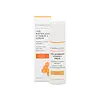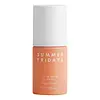What's inside
What's inside
 Key Ingredients
Key Ingredients

 Benefits
Benefits

 Concerns
Concerns

No concerns
 Ingredients Side-by-side
Ingredients Side-by-side

Water
Skin ConditioningNiacinamide
SmoothingButylene Glycol
Humectant3-O-Ethyl Ascorbic Acid
Skin ConditioningAscorbyl Glucoside
AntioxidantGlycerin
HumectantCapryloyl Glycerin/Sebacic Acid Copolymer
Skin ConditioningHydroxyethyl Acrylate/Sodium Acryloyldimethyl Taurate Copolymer
Emulsion StabilisingSqualane
EmollientSodium Citrate
BufferingPhenoxyethanol
PreservativeSodium Hydroxide
BufferingCitric Acid
BufferingDiheptyl Succinate
EmollientTocopheryl Acetate
AntioxidantXanthan Gum
EmulsifyingTetrasodium Glutamate Diacetate
Carbomer
Emulsion StabilisingPolysorbate 20
EmulsifyingPalmitoyl Oligopeptide
CleansingPalmitoyl Tetrapeptide-7
Skin ConditioningCamellia Oleifera Leaf Extract
AstringentEthylhexylglycerin
Skin ConditioningOrchis Mascula Flower Extract
SoothingCaprylic/Capric Triglyceride
MaskingCananga Odorata Flower Extract
PerfumingCucumis Melo Cantalupensis Fruit Extract
AstringentEugenia Caryophyllus Flower Extract
AstringentGlycine Soja Oil
EmollientPyrus Malus Fruit Extract
Skin ConditioningPrunus Armeniaca Fruit Extract
Skin ConditioningRosa Gallica Flower Extract
AstringentCinnamomum Cassia Bark Extract
MaskingJasminum Officinale Flower/Leaf Extract
MaskingCoffea Arabica Leaf/Seed Extract
MaskingCamellia Sinensis Leaf Extract
AntimicrobialAmyl Cinnamal
PerfumingCinnamyl Alcohol
PerfumingCitronellol
PerfumingEugenol
PerfumingHydroxycitronellal
PerfumingWater, Niacinamide, Butylene Glycol, 3-O-Ethyl Ascorbic Acid, Ascorbyl Glucoside, Glycerin, Capryloyl Glycerin/Sebacic Acid Copolymer, Hydroxyethyl Acrylate/Sodium Acryloyldimethyl Taurate Copolymer, Squalane, Sodium Citrate, Phenoxyethanol, Sodium Hydroxide, Citric Acid, Diheptyl Succinate, Tocopheryl Acetate, Xanthan Gum, Tetrasodium Glutamate Diacetate, Carbomer, Polysorbate 20, Palmitoyl Oligopeptide, Palmitoyl Tetrapeptide-7, Camellia Oleifera Leaf Extract, Ethylhexylglycerin, Orchis Mascula Flower Extract, Caprylic/Capric Triglyceride, Cananga Odorata Flower Extract, Cucumis Melo Cantalupensis Fruit Extract, Eugenia Caryophyllus Flower Extract, Glycine Soja Oil, Pyrus Malus Fruit Extract, Prunus Armeniaca Fruit Extract, Rosa Gallica Flower Extract, Cinnamomum Cassia Bark Extract, Jasminum Officinale Flower/Leaf Extract, Coffea Arabica Leaf/Seed Extract, Camellia Sinensis Leaf Extract, Amyl Cinnamal, Cinnamyl Alcohol, Citronellol, Eugenol, Hydroxycitronellal
 Reviews
Reviews

Ingredients Explained
These ingredients are found in both products.
Ingredients higher up in an ingredient list are typically present in a larger amount.
Citric Acid is an alpha hydroxy acid (AHA) naturally found in citrus fruits like oranges, lemons, and limes.
Like other AHAs, citric acid can exfoliate skin by breaking down the bonds that hold dead skin cells together. This helps reveal smoother and brighter skin underneath.
However, this exfoliating effect only happens at high concentrations (20%) which can be hard to find in cosmetic products.
Due to this, citric acid is usually included in small amounts as a pH adjuster. This helps keep products slightly more acidic and compatible with skin's natural pH.
In skincare formulas, citric acid can:
While it can provide some skin benefits, research shows lactic acid and glycolic acid are generally more effective and less irritating exfoliants.
Most citric acid used in skincare today is made by fermenting sugars (usually from molasses). This synthetic version is identical to the natural citrus form but easier to stabilize and use in formulations.
Read more about some other popular AHA's here:
Learn more about Citric AcidGlycerin is already naturally found in your skin. It helps moisturize and protect your skin.
A study from 2016 found glycerin to be more effective as a humectant than AHAs and hyaluronic acid.
As a humectant, it helps the skin stay hydrated by pulling moisture to your skin. The low molecular weight of glycerin allows it to pull moisture into the deeper layers of your skin.
Hydrated skin improves your skin barrier; Your skin barrier helps protect against irritants and bacteria.
Glycerin has also been found to have antimicrobial and antiviral properties. Due to these properties, glycerin is often used in wound and burn treatments.
In cosmetics, glycerin is usually derived from plants such as soybean or palm. However, it can also be sourced from animals, such as tallow or animal fat.
This ingredient is organic, colorless, odorless, and non-toxic.
Glycerin is the name for this ingredient in American English. British English uses Glycerol/Glycerine.
Learn more about Glycerin